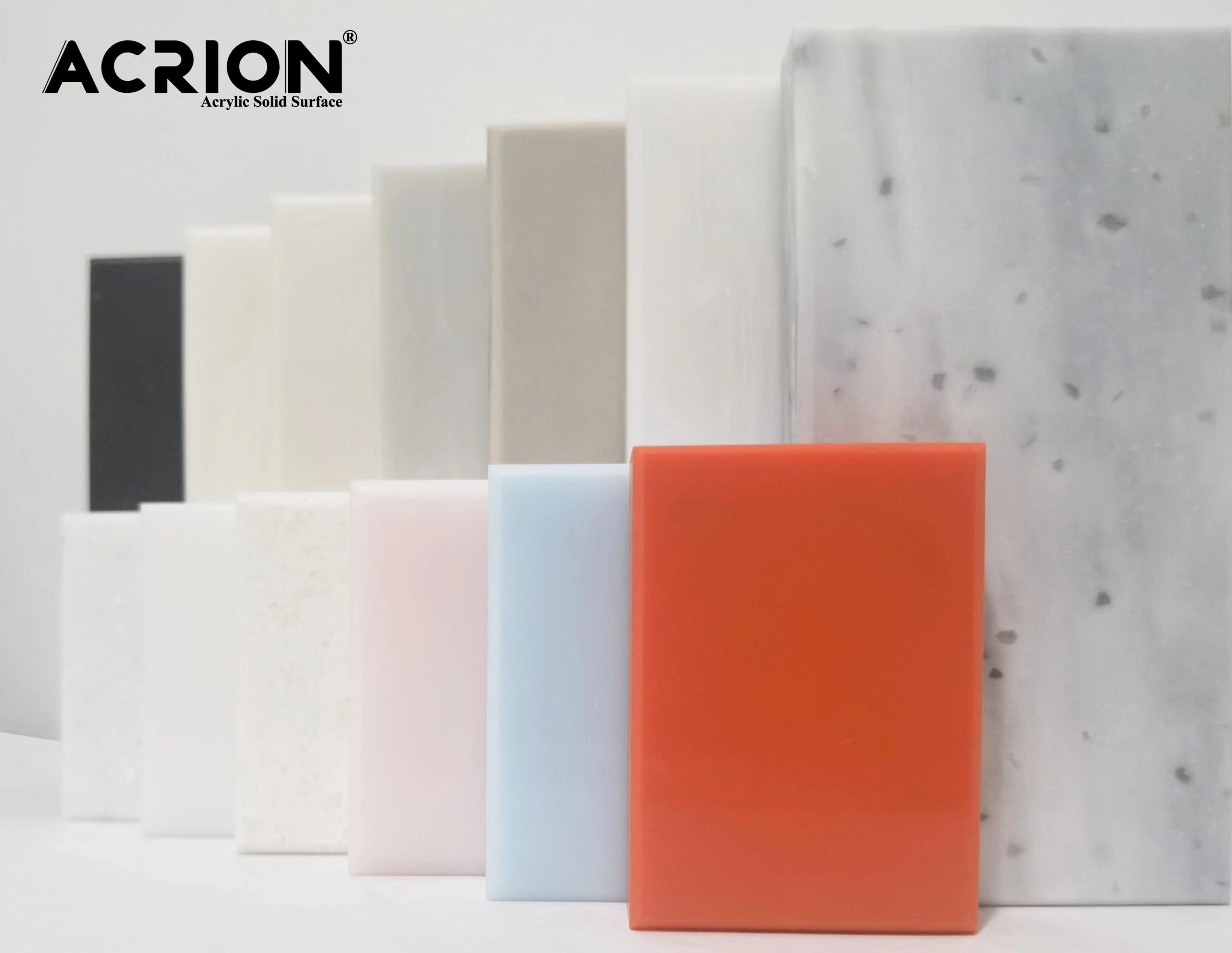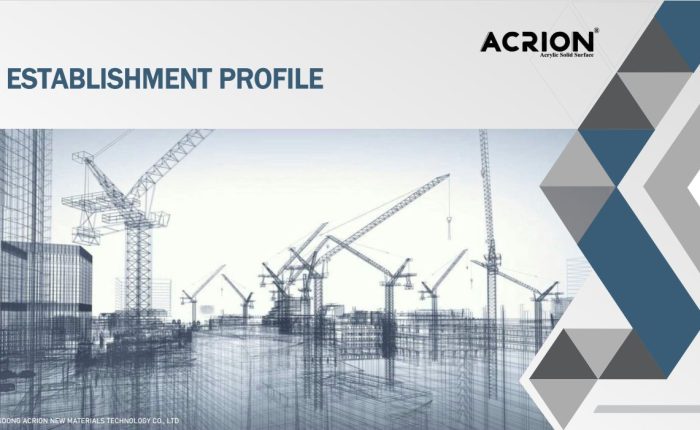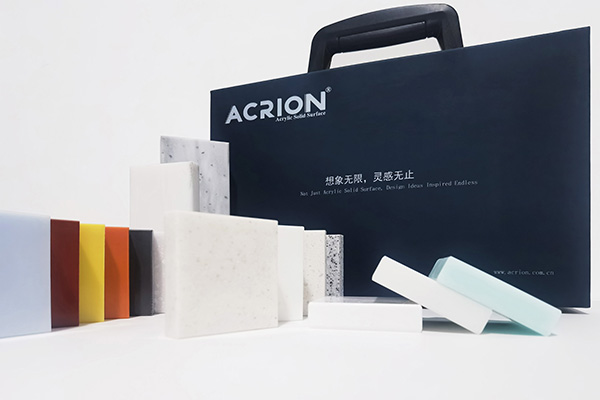Analyse der Flexibilität und Plastizität von Acryl -festen Oberflächen
Die Flexibilität und Plastizität der festen Oberfläche von Acrylsäure wird gemeinsam durch die molekulare Struktur des Harzes, des Aushärtungsmechanismus und der äußeren Bedingungen beeinflusst. Die folgende Analyse erfolgt aus drei Dimensionen: Materialeigenschaften, Einflussfaktoren und Anwendungsszenarien:
Erstens die Quellen und Manifestationen der Flexibilität
Molekulare Kettenflexibilität
Die Flexibilität von Acrylharz hängt hauptsächlich von der Struktur der Estergruppe (-COO-) und der Alkylgruppe (-R) in der Hauptkette ab. Beispielsweise kann die Einführung langkettiger Alkylgruppen (wie C8-C12) das freie Volumen der Molekülkette erhöhen, die Glasübergangstemperatur (Tg) senken und dadurch die Flexibilität erhöhen. Wenn flexible Monomere (z. B. Butylacrylat) in die Hauptkette eingeführt werden, kann die Beschichtung einer Biegung um 180° bei Raumtemperatur standhalten, ohne zu reißen. Bei einem zu hohen Anteil harter Monomere (z. B. Methylmethacrylat) nimmt die Sprödigkeit der Beschichtung jedoch deutlich zu.
Der Einfluss der Vernetzungsdichte
Die Dosierung von Vernetzungsmitteln (wie Diisozyanaten und Epoxidharzen) wirkt sich direkt auf die Flexibilität aus. Wenn beispielsweise die Vernetzungsdichte zu hoch ist, kann die Beschichtung während des Biegetests aufgrund der Spannungskonzentration brechen. Eine moderate Vernetzung (wie ein Vernetzungsgrad von 30 bis 50%) kann die Härte und Flexibilität ausgleichen, wodurch die Beschichtung eine gewisse Härte aufrechterhalten und gleichzeitig die Wirkung widerstandsfähig ist.
Temperaturabhängigkeit
Die Flexibilität der Acrylbeschichtung nimmt mit dem Temperaturanstieg zu. Zum Beispiel kann die Beschichtung bei -20 ℃ spröde Fraktur aufweisen; Bei 60 ° C kann seine Dehnung bei der Pause um das 2- bis 3 -fache steigen. Diese Eigenschaft erfordert, dass die Formel bei Verwendung in Umgebungen mit niedriger Temperaturen optimiert werden muss (z. B. Hinzufügen von Plastizierern), um die Flexibilität aufrechtzuerhalten.
Zweitens der Realisierungsmechanismus der Plastizität
Thermoplastische Verarbeitung
Unvollständig ausgehärtetes Acrylharz kann durch thermoplastische Verarbeitung Plastizität erreichen. Beispielsweise kann das Harz bei 120–150 °C kalandriert, blasgeformt oder spritzgegossen werden und behält nach dem Abkühlen seine Form. Diese Eigenschaft gilt für die Herstellung komplex geformter Produkte (z. B. unregelmäßig geformter dekorativer Teile), die Verarbeitungstemperatur muss jedoch kontrolliert werden, um eine thermische Verschlechterung zu vermeiden.
Lösungsmittelunterstützte Formgebung
Durch Zugabe flüchtiger Lösungsmittel (z. B. Ethylacetat) kann die Viskosität des Harzes verringert und seine Plastizität erhöht werden. Wenn der Lösungsmittelgehalt beispielsweise 20–30 % beträgt, kann das Harz in einer dünnen Schicht aufgetragen oder aufgesprüht werden, und nach dem Verdunsten des Lösungsmittels bildet sich eine dichte Beschichtung. Diese Methode ist auf großflächige Konstruktionen (z. B. Außenwände von Gebäuden) anwendbar, es muss jedoch auf den Einfluss der Lösungsmittelverdampfungsrate auf die Ebenheit der Beschichtung geachtet werden.
Lichthärtend und reversible Vernetzung
Einige Acrylharze können durch Photoinitiatoren photogehärtet werden, während reversible Vernetzungsbindungen (wie Disulfidbindungen und Wasserstoffbrückenbindungen) eingeführt werden, um die Plastizität zu verbessern. Beispielsweise kann das Harz unter Bestrahlung mit ultraviolettem Licht innerhalb von Sekunden ausgehärtet und geformt werden. Unter dem Einfluss von Erhitzen oder bestimmten Lösungsmitteln können die vernetzenden Bindungen aufbrechen und eine sekundäre Formgebung erreicht werden. Diese Funktion ist auf Szenarien anwendbar, die eine wiederholte Verarbeitung erfordern (z. B. 3D-Druck).
Drittens, die Schlüsselfaktoren, die Flexibilität und Plastizität beeinflussen
Zusammensetzung der Harzmonomere
Das Verhältnis von weichen Monomeren (wie Ethylacrylat und Isooctylacrylat) zu harten Monomeren (wie Methylmethacrylat und Styrol) wirkt sich direkt auf die Flexibilität aus. Wenn beispielsweise der Anteil an weichen Monomeren 60 % übersteigt, wird die Flexibilität der Beschichtung deutlich verbessert, die Härte kann jedoch unzureichend sein. Bei einem zu hohen Anteil an Hartmonomeren neigt die Beschichtung zur Rissbildung.
Weichmacher und Modifikatoren
Weichmacher (wie Dioctylphthalat) können zwischenmolekulare Kräfte reduzieren und die Flexibilität erhöhen. Beispielsweise kann die Zugabe von 5-10 % Weichmacher die Bruchdehnung der Beschichtung um mehr als 50 % erhöhen, allerdings kann dies zu einer Verringerung der Hitze- und Chemikalienbeständigkeit führen. Darüber hinaus kann die Einführung von Nanofüllstoffen (wie Siliziumdioxid und Kohlenstoffnanoröhren) durch physikalische Vernetzung die Flexibilität und Festigkeit verbessern.
Aushärtebedingungen
Die Härtungstemperatur und die Zeit haben einen signifikanten Einfluss auf Flexibilität und Plastizität. Beispielsweise kann die Härtung mit niedriger Temperatur (wie 40 ℃) zu einer unvollständigen Vernetzung führen, was zu einer Beschichtung mit guter Flexibilität, aber unzureichender Härte führt. Hochtemperaturhärtung (z. B. 120 ℃) kann die Vernetzungreaktion beschleunigen, die Härte erhöhen, aber die Flexibilität verringern. Darüber hinaus kann die Flexibilität der UV-härtbaren Beschichtung gesteuert werden, indem die Konzentration des Photoinitiators und die Intensität des Lichts angepasst werden.
Viertens die Anforderungen an Flexibilität und Plastizität in Anwendungsszenarien
Architekturbeschichtung
Außenwandbeschichtungen müssen einen gewissen Grad an Flexibilität aufweisen, um die durch Temperaturänderungen verursachte Wärmeausdehnung und Kontraktion zu widerstehen. Zum Beispiel muss die Beschichtung in Gebieten mit einem großen Temperaturunterschied zwischen Tag und Nacht eine Dehnung bei Unterbrechung von 10-15% aufweisen, um ein Risse zu verhindern. Darüber hinaus erfordert Plastizität, dass die Beschichtung die Oberfläche komplexer Substrate (wie Ziegelwände und Stein) gleichmäßig bedecken kann.
Automobilbeschichtung
Komponenten wie Auto -Stoßstangen müssen sowohl flexibel als auch formbar sein. Beispielsweise muss die Beschichtung die Flexibilität im Bereich von -40 bis 80 ° C aufrechterhalten und gleichzeitig geringfügigen Auswirkungen standhalten, ohne sich abzuwehren. Darüber hinaus erfordert Plastizität, dass sich die Beschichtung an den Injektionsformprozess anpassen und eine glatte Oberfläche bilden kann.
3D -Druckmaterialien
UV-harmable Acrylharz muss formbar sein, um komplexe Strukturen zu drucken. Zum Beispiel muss das Harz bei ultraviolettem Licht schnell heilen und gleichzeitig ein gewisses Maß an Flexibilität beibehalten, um Bruch während des Druckprozesses zu verhindern. Darüber hinaus müssen die gedruckten Produkte eine ausreichende Kraft haben, um der Nutzungsbelastung standzuhalten.
Fünftens: Strategien zur Verbesserung von Flexibilität und Plastizität
Molekulares Design
Flexible Segmente werden durch Copolymerisation oder Pfropfmodifikation eingeführt. Beispielsweise kann die Einführung von Polyethersegmenten (z. B. Polyethylenglykolmethacrylat) in Acrylharz die Flexibilität erheblich verbessern und gleichzeitig die Wasserbeständigkeit beibehalten.
Verbundmodifikation
Mischen Sie Acrylharz mit Elastomeren (z. B. Nitrilkautschuk, Polyurethan). Beispielsweise kann die Zugabe von 10–20 % Elastomer die Schlagfestigkeit der Beschichtung um das 3–5-fache erhöhen, während die Transparenz erhalten bleibt.
Nachbehandlungsprozess
Optimieren Sie die Beschichtungsstruktur durch Wärmebehandlung oder Lösungsmittelglühen. Beispielsweise kann eine zweistündige Wärmebehandlung bei 100 °C die innere Spannung der Beschichtung abbauen und ihre Flexibilität erhöhen. Lösungsmittelglühen kann die Neuordnung von Molekülketten fördern und die Plastizität verbessern.



